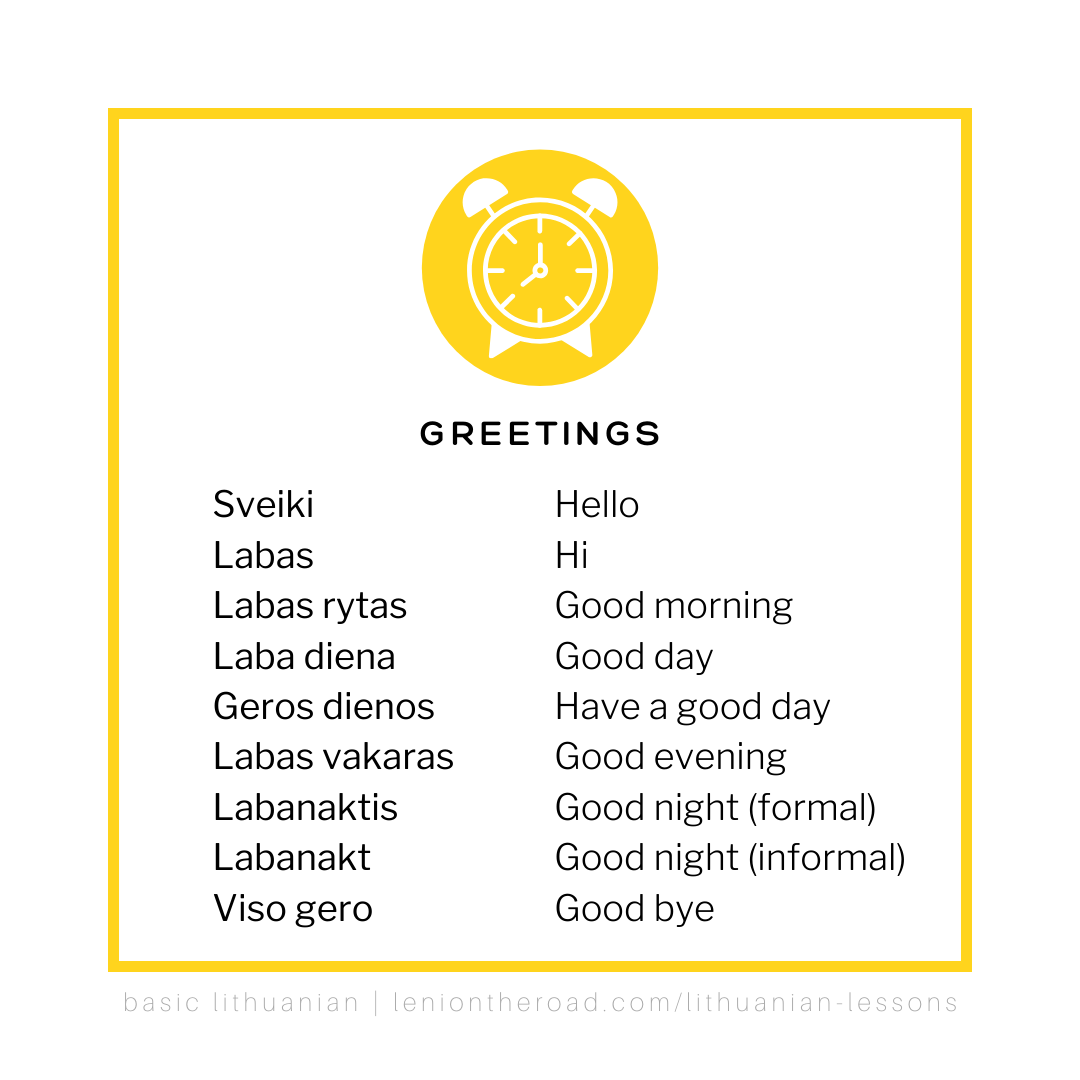Greetings and introduction in Lithuanian
As with any language, the first most practical lesson there is to learn is greeting and introducing oneself. Before any communication or simple conversation, the speaker must first establish the need to talk and gain the consent and trust of their interlocutor. This is initiated by expressions on greetings.
In every country and culture, it is always appreciated if we try as much as we can to put in a minimum effort to get in touch in their ways ; to remain open and understanding. One of the essential things to remember when visiting a foreign country is that their way of life or how they operate certain aspects in their lives might not be similar to that of yours so it is best to keep an open mind and to do a bit of research. Thankfully, with the internet, we are able to access basic information like this.
Here’s my effort to help bridge those gaps in the Lithuanian language. Check back frequently for more progressive lessons on basic Lithuanian expressions.
These short courses are free and should not be used for profitable activities.
“Laba diena ! Mano vardas Leni. O jūs ? Koks jūsų vardas ? Malonu susipažinti. Iki pasimatymo !”
Let us deconstruct the different parts of this short introduction.
Greetings
Laba diena is a generic greeting in Lithuanian which literally means good day. Depending on the time of the day, you can opt to change it to the following:
Labas rytas (good morning)
Labas vakaras (good evening)
Another generic term they use is Sveiki (pl) Sveikas (sg,m) or Sveika (sg,f). This is a little bit more tricky because you have to factor in gender. For speakers of languages which already involve gender, this might not seem to be a problem. For English speakers, this can be tricky. This greeting depends in terms of the gender of the person you’re addressing.
Sveikas - (singular masculine) speaking with one male
Sveika - (singular feminine) speaking with one female
Sveiki - (plural either masculine or feminine) speaking with a group of people or speaking in a respectful way i.e. to a person of authority.
This greeting literally means you’re wishing someone good health. The safest is to use Sveiki, a more formal, respectful and neutral term.
Introduction
Mano vardas literally translates to “my name (is)”. Notice that with this expression, we have omitted the verb “is”. Technically, this sounds like saying “my name Leni”, which may seem odd for an English speaker. This is the complete thought in Lithuanian and it is sufficient to introduce and identify yourself with your name. Mano is a possessive adjective and its English equivalent is “my”.
Koks jūsų vardas is a question asking for the other person’s name: what’s your name? As you might have already figured out, jūsų is the possessive adjective which translates to “your” in English.
This leaves us another newly encountered word: koks, which is the interrogative word for the English “what”.
Koks jūsų vardas is a more formal, respectful way of asking somebody else’s name. If you want to be more informal and casual, especially to people of the same age range, simply replace jūsų with tavo: Koks tavo vardas? Tavo also translates to “your” in English. However, it is used for more informal situations.
Here are the possessive adjectives in Lithuanian:
mano (my)
tavo (your, informal, singular)
jos (her)
jo (his)
mūsų (our)
jūsų (your, formal, singular and/or plural)
jų (their)
Expressions
To end the short introduction, we mentioned malonu susipažinti, nice to meet you and iki pasimatymo, see you next time. I understand how tricky it might be pronounced. Good news, you can actually do away with the longer words. You can simply say “malonu” to mean it was a pleasure and “iki” to mean until (then/next time). Fun fact, Iki is also the name of a popular Lithuanian supermarket
This is not to say that the words we left out are without meaning. Susipažinti is actually a Lithuanian verb which translates to “to get acquainted”, while pasimatymo means a date or a rendez-vous.
Other greetings to say goodbye
Although not covered in our sample sentence, here are other expressions to end your short introduction. Don’t end your conversation awkwardly but terminate it with finesse using the following expressions in the most appropriate situation you choose:
Geros dienos (have a good day)
Labanaktis (good night, formal)
Labanakt (good night, informal)
Viso gero (good bye)
Try it yourself! Comment below by saying hello (expression of your choice), introducing yourself, asking me back and saying goodbye (expression of your choice).
Was this helpful? There’s more to come! Let me know which topics you want to cover on future modules.
Follow this Pinterest board for other trivial information about the lietuviškai (Lithuanian language) and Lietuva (Lithuania)
This was me introducing myself in Lithuanian (only half an hour after learning the basic expressions) during the first day of language school in 2018
My short Lithuanian Linguistic Biography
In 2017, 2018 and 2019, I was a recipient of the Lithuanian government scholarship for the winter and summer Lithuanian language and culture courses. However, I only chose to attend the summer courses given my work schedule. In those two months, I have learned as much as to introduce myself, get around, let others know what I need and am looking for and describe myself and those in my immediate surroundings. In the Common European Framework of Reference for Languages (CEFR), these skills are categorized in the A2 level. In this level, the language user is able to talk and ask questions about themselves and those of their immediate surroundings, regarding their immediate and personal needs. This level is enough to get you through the day to day necessities such as lodging, restaurant, hotel reservations, ordering food, buying in shops… just about anything you need to function better as a tourist or temporary visitor. Read more…








